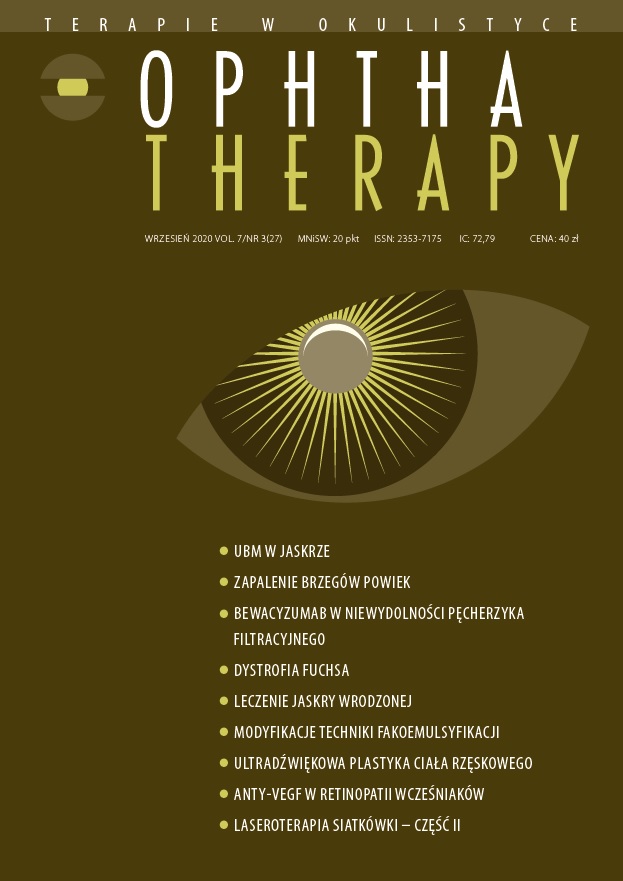Anti-VEGF drugs in treatment of retinopathy of prematurity Review article
Main Article Content
Abstract
Retinopathy of prematurity is a serious disease that can lead to retinal detachment and vision loss. Vascular endothelial growth factors (VEGF) play a key role in the pathogenesis of this disease. The gold standard of treatment used since the 1990s is laser coagulation of non-vascularized retina. Anti-VEGF drugs introduced in recent years administered as intravitreal injections neutralize excess VEGF factors. The main advantage of these drugs is very fast action, very short and uncomplicated administration procedure, full field of view expected. Drugs, however, are absorbed into the bloodstream, which can affect the physiological maturation of internal organs in a child born prematurely. Another important problem is the appearance of late recurrences of retinopathy, even several months after the injection. These drugs should be used prudently, especially in patients with retinopathy in zone I.
Downloads
Article Details

This work is licensed under a Creative Commons Attribution-NonCommercial-NoDerivatives 4.0 International License.
Copyright: © Medical Education sp. z o.o. License allowing third parties to copy and redistribute the material in any medium or format and to remix, transform, and build upon the material, provided the original work is properly cited and states its license.
Address reprint requests to: Medical Education, Marcin Kuźma (marcin.kuzma@mededu.pl)
References
2. Hellstrom A, Smith LE, Dammann O. Retinopathy of prematurity. Lancet. 2013; 382(9902): 1445-57.
3. Hansen ED, Hartnett ME. A review of treatment for retinopathy of prematurity. Expert Rev Ophthalmol. 2019; 14(2): 73-87.
4. Hartnett EM. VEGF antagonist therapy for ROP. Clin Perinatol. 2014; 41(4): 925-43.
5. Early Treatment for Retinopathy of Prematurity Cooperative Group. Revised indications for treatment of retinopathy of prematurity: results of the early treatment for retinopathy of prematurity randomized trial. Arch Ophthalmol. 2003; 121: 1684-94.
6. Hautz W. Ocena wyników leczenia retinopatii wcześniaków przy użyciu laserowej fotokoagulacji. Praca doktorska. Instytut „Pomnik – Centrum Zdrowia Dziecka”, Warszawa 2004.
7. Multicenter Trial of Cryotherapy for Retinopathy of Prematurity. Three-month Outcome. Cryotherapy for Retinopathy of Prematurity Cooperative Group. Arch Ophthalmol. 1990; 108(2): 195-204.
8. Arima M, Akiyama M, Fujiwara K et al. Neurodevelopmental outcomes following intravitreal bevacizumab injection in Japanese preterm infants with type 1 retinopathy of prematurity. PLoS ONE. 15(3): e0230678.
9. Wong RK, Hubschman S, Tsui I. Reactivation of Retinopathy of Prematurity after Ranibizumab Treatment. Retina. 2015; 35(4): 675-80.
10. Stahl A, Hellstrom A, Smith LE. IGF-1 and Anti-VEGF in ROP: Has the time come? Neonatology. 2014; 106(3): 254-60.
11. VanderVeen DK, Meila M, Yang MB et al. Anti-vascular endothelial growth factor therapy for primary treatment of type 1 retinopathy of prematurity. Ophthalmology. 2017; 124: 619-33.
12. Zang G, Yang M, Zeng J et al. Comparsion of intravitreal injection of ranibizumab versus laser theapy for zone II treatment – requiring retinopatopathy of prematurity. Retina. 2017; 37: 710-7.

